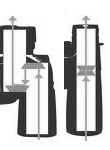
Best Bird Watching Binoculars
Reviews & Recommendations (2024)
Choosing the best bird watching binoculars really comes down to individual preference.
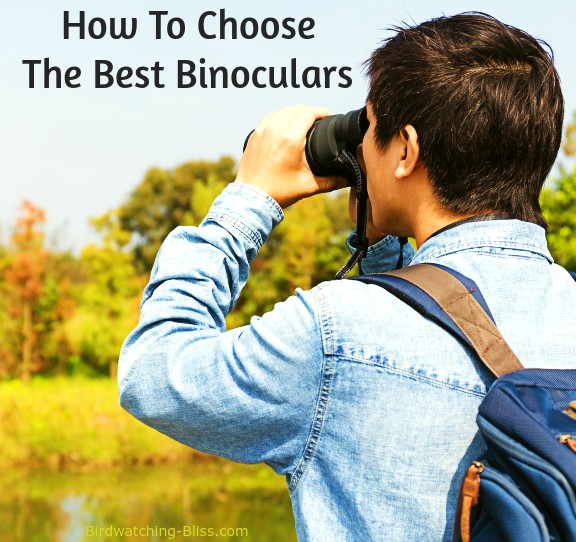
What's important to you may not be important to someone else.
Below we will discuss how to choose birding binoculars and what features to look for and their definitions including magnification, objective lens size, close focus, weatherproofing, prism design and more.
 You can also skip to our review page to view the top
4 binocular picks by
price range here:
You can also skip to our review page to view the top
4 binocular picks by
price range here:
--> Best Binoculars for Birding (2024)
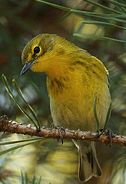 We
all know that trying to spot a warbler flitting around in the conifers with
binoculars is a bit more challenging than focusing on an elephant on an
African safari!
We
all know that trying to spot a warbler flitting around in the conifers with
binoculars is a bit more challenging than focusing on an elephant on an
African safari!
Needless to say, birders need more in a binocular than the average elephant-watcher.
Having a good pair of binoculars may make the difference between identifying that life bird or not.
So what are the best binoculars for bird watching?
There are a lot of features these days on binoculars that need to be considered when making a purchase.
- Should I get 7x35, 8x42, 10x50?
- Should I choose Porro or Roof Prism?
- Do I need my binoculars to be Nitrogen-Purged?
- Fully Multi-Coated? ED, Extra-Low Dispersion?
- Rubber Armored Coating?
- Field of View, Close Focus, Exit Pupil...Oh My!
What does it all mean?!
Lets start with some of the basics and what each means to ultimately choosing the best bird watching binoculars.
We will further explain binocular magnification, objective lens diameter, exit pupil size, prism design, close focus, eye relief, field of view, lens coatings, weight, waterproofness and rubber armoring.
Binocular Magnification
Binoculars are categorized by a set of numbers such as: 7x35, 8x42, 10x50, etc.
The first number is the magnification or how many times closer an object will appear than without magnification.
So with the 7x35s, objects will appear 7 times closer, 10x50s, 10 times closer.
objects will appear 7 times closer, 10x50s, 10 times closer.
For example, if you have an 8 power binocular and you are 80 feet away, the image will appear as though it is 10 feet away.
Why Not Get The Highest Magnification?
Most birders will choose a binocular with a magnification of 7, 8 or 10.
But why wouldn't you want the highest magnification?
Obviously, higher magnification will give you a closer & more detailed look. But there are some drawbacks...
Lower power binoculars will allow you to see more because of a wider field of view (FOV discussed later).
Basically, the higher the magnification, the narrower the field of view.
You can see more of what you looking at through 7x than 10x.
You'll also have a better chance of spotting a bird & following it as it jumps around in the trees with 7x than 10x.
Additionally, if you are watching flocks of birds, you will see more individuals in a 7x than 10x.
Comparing 7x40 with 10x40s (same objective lens size), the 7x will also give you a brighter image because image brightness decreases with higher magnifications.
This is especially helpful in low light conditions, i.e. owl watching, in dense forests, and at dusk & dawn.
Higher Magnification Disadvantages in Birding Binoculars:
- Smaller field of view
- Less light (bird image will be not be as bright)
- Have to hold more steady - higher magnification exaggerates shaking when hand-held (you can use a binocular tripod adapter to help with this)
- Heavier
- More difficult to focus on close objects
- Takes more time to focus - more focus wheel rotations
The above taken into consideration, you still may prefer 10x over 7x or even 8x, especially if you plan to use your bird watching binoculars mostly for:
- Distant bird watching such as shorebirds or raptors
- Viewing in wide-open situations
- Viewing birds not as active such as waterfowl
If you require anything above 10x, you should consider using spotting scopes because binoculars above that magnification power will be too difficult to hold steady.
Or you can try a pair of high power binoculars with a binocular tripod adapter.
Ideal Magnification
If you plan on using one pair of binoculars for all your birding, 8x are a good compromise and is the choice of many birders.

When it comes down to it, a 10x binocular, although offering slightly more detail, will not make the difference between you being able to identify a bird or not.
So for the sake of price & comfort, you may want to choose a pair of 8x or 7x.
It will provide you with the best value for your money as well.
You should stay away from low-priced (< $100) 10x binoculars!
You will be better off purchasing a $50 pair of 8x because typically flaws increase as magnification increases in cheaper models.
7x and 8x are better especially for beginners who may need a larger field of view to spot and follow active birds.
Decide what's important to you...
- More detail or brightness of image?
- Heavy or lightweight?
- Do you have shaky hands?
- Is it easy for you to spot birds through binoculars?
- Do you need a broad field of vision or small?
If you can, borrow different kinds of binoculars to see what works best for you.
Objective Lens Diameter
The second number on the binoculars is the the
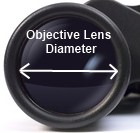 diameter in millimeters of the objective lens (front, big, fat lens on far side).
diameter in millimeters of the objective lens (front, big, fat lens on far side).
So 7x35s has a lens size of 35mm, 8x42, 42mm.
Why does it matter?
This is where light enters your binoculars.
So the bigger the lens, the greater its light gathering capacity & the brighter your bird will be - the better detailed field marks will be able to see & colors will be more brilliant.
So why not have the biggest lens?
Because bigger means bulkier & heavier.
A 50mm lens is as big & heavy as you would want to go.
Fine if you're sitting on your backyard lounger, bad for a week-long backpacking trip. Weight of binoculars is discussed in more detail later.
When I was choosing my first pair of bird watching binoculars many years ago, I was told to get binoculars with an objective lens size 5 times greater than the magnification.
So if you are choosing 8x binoculars, the objective lens size should be at least 40 (8x40), 10x binoculars should be 10x50, etc.
However, optic quality has increased greatly over the years and now you don't necessarily have to follow that rule, at least for binoculars priced $200 and up.
As a general guideline, choose a lens size between 30-50mm.
Compact binoculars usually will have lens sizes below 30mm.
Yes, they will be lightweight, but you lose light and handling comfort.
So don't choose compact binoculars if it is going to be your only pair.
The popular sizes for bird watching binoculars are 8x40s or 8x42s after comparing brightness, field of view, and weight with smaller & bigger binoculars.
An objective lens size of 30mm is the smallest any birder would want to go.
If you often use your bird watching binoculars for viewing owls and other birds in low light conditions (dense, dark woods or at dusk & dawn), then consider a bigger objectives lens.
More light gathering means more detail when the light level drops, and therefore, more quality birding time when the birds are active.
And keep this in mind too, a high quality 40mm lens will give you a better image overall, than a cheap 50mm lens.
Increasing Objective Lens Size =
- More light
- More weight
- More expense
Exit Pupil
The exit pupil is the diameter of light in millimeters visible through the eyepiece.
through the eyepiece.
It is determined by dividing the objective lens diameter by the magnifying power.
So a pair of 10x50s would have an exit pupil size of 5mm (50/10 = 5). 8x32s would have an exit pupil size of 4mm (32/8 = 4)
You can see this beam of light when you hold up your binoculars (eyepieces towards you).
It appears as a tiny circle of light in each eyepiece.
The circle of light is the magnified image as it exits the binoculars and enters your eye.
The bigger the diameter, the better you'll see in dim light, up to the maximum diameter of the human pupil itself, generally between 4mm to 7mm, depending on age and available light.
Here is a good video that helps demonstrate and explain exit pupil:
Obviously then, the larger the exit pupil, the more light gathering capacity, and the brighter your bird image will be.
If the exit pupil size is near the same size of our pupil, it will be more difficult to find images.
For example, in bright light when our pupils are contracted to 2-3mm, those compact 8x21 binoculars (exit pupil = 2.6) are going to be difficult to use because our eyes are going to have to be centered exactly over the exit pupil to find our bird.
Trying to follow an arctic tern on a rocky boat with a pair of compacts will have you barking at the buoys in no time!
The image will also appear darker and not as clear.
For general purpose birding, choose a pair of binoculars with an exit pupil size of at least 4mm.
If you do most of your birding in shaded conditions (thick forests), dim light (owling) or on boats, choose 5mm or more.
Prism Design
There are two types of prism systems, porro & roof:
Porro Prism
Porro prism binoculars have a z-shaped optical path where the objective lenses are offset from the eyepieces, resulting in a wider set of binoculars.
View The Best Porro Prism Binoculars
Roof Prism
In roof prism binoculars, the prisms overlap closely and the objective lenses are approximately in line with the eyepieces.
The result is a slim, streamlined shape.
Because of the pricier technology required, roof prism binoculars are more expensive than porro prism binoculars.
You can get an excellent pair of porro prism birding binoculars priced around $250.
View The Best Mid-Priced Roof Prism Binoculars
To get the equivalent optic quality in a pair of roof prism binoculars, you would have to pay around $400 and up.
So if you're on a budget, porro prisms may be your best option.
Remember though, that because porro prism binoculars are not as rugged and durable as roof prism binoculars, you may be better off in the long run with a roof prism if you can afford it.
Comparing Porro vs Roof Prism Designs
for Bird Watching
Binoculars
|
Porro |
Roof |
 |
 |
| Big & bulky | Slim & stream-lined |
| Heavy | Lightweight |
| External focus: o-ring seals' degrade & allow dirt & water to penetrate interior | Internal focus - easier to waterproof & seal |
| Wider field of view | Prisms overlap closely, smaller field of view |
| Wider offset lenses provide greater depth perception | Straight inline barrels decrease depth perception |
| More light gathering capacity = brighter | Can be as bright as porro with proper lens coating (PC phase corrected coating) = $$ |
| 2 offset prisms mounted separately - more susceptible to alignment problems if dropped - weaker design | 2 separate prisms cemented together as a single interior mount - stronger, more durable design |
| You can get a better quality binocular for less $$ | Costs more for comparable porro quality |
Close Focus
Close focus is the shortest distance at which the binocular is capable of providing a sharply focused image of an object.
As a general rule, as magnification increases, the minimum close focal distance also increases.
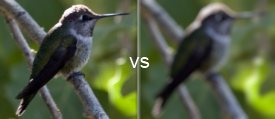
So yet another trade-off for you to consider: More magnification or shorter-distance close focus?
Especially of interest to birders because there will be times when you will want to see the detail of a bird less than 15 or even 10 feet away.
Therefore, a good birding binocular should have a minimum close focus of 15 feet, 10 feet would be better.
If you like to view other creatures up close such as butterflies, reptiles, etc. close focus is also an advantage.
Ease of Focusing
A good pair of bird watching binoculars will allow you to get a quick & sharp focus of your bird.
This is important in because many birds are constantly moving around and you will need to be able to focus quickly.
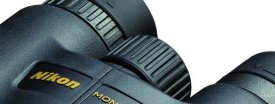
A good focus mechanism will focus from close to far with one full revolution of the dial or less.
You don't want to have to turn the knob too many times in order to bring a bird into focus.
And make sure you get a pair of binoculars with a central focus that you can comfortably turn with your index finger.
It should turn smoothly, without much effort.
You will find that most birding binoculars do have central focus.
Some models of binoculars have individual focus eyepieces which must be adjusted when looking at birds closer than about 30 feet, which is awkward and time consuming for bird watching.
Again, you get what you pay for so you'll find that more expensive bird watching binoculars have finer-tuned focus mechanisms.
Below we will cover binocular eye relief, field of view, prism and lens coatings, prism glass types, and rubber armor coating.
Binocular Eye Relief/Eye Cups
This is an important element for eyeglass wearers.
Eye relief is the distance measured in millimeters a binocular can be held away from the eye and still present the full field-of-view image in focus.
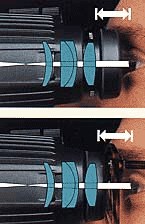
Eyecups are usually designed so that the eye relief is the right distance for non-eyeglass wearers, between 9-13mm.
However, eyeglass wearers need greater eye relief to compensate for the distance their glasses stand away from their pupils.
The problem occurs when there is not enough eye relief, resulting in a narrower field of view.
You want to be able to use your birding binoculars without having to constantly remove your eyeglasses to look.
That can cost valuable time when trying to spot a bird.
Some binoculars will have rubber eyecups that fold down to get your eyes/eyeglasses closer to the lenses, while other more expensive models will have adjustable eyecups.
Below is a video that demonstrates and explains the importance of eye relief, especially for those who wear eyeglasses:
As a general guideline, for those who wear thinner, closer fitting glasses choose an eye relief between 14-15mm.
For those who wear thicker, farther fitting glasses, choose 16-18mm.
View The Best Binoculars For Eyeglass Wearers
Of course, your best bet would be to try out several binoculars & see what works best with your particular eyeglasses.
It is still a good idea for non-eyeglass wearers to also try out binoculars for eye relief as well, to find the distance that works best for them.
Field of View (FOV)
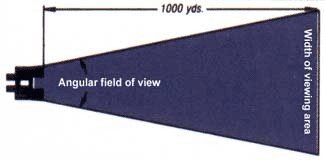 The field of view is measured as the width of area visible at 1,000 yards (or meters) from the observer.
The field of view is measured as the width of area visible at 1,000 yards (or meters) from the observer. It is sometimes expressed as degrees near the eyepiece (i.e. "Field 6.5 degrees").
The eyepiece design mainly determines the the field of view.
If the angular field of view in degrees is provided, you can calculate the FOV by multiplying the number by 52.5 (the # of feet in 1 degree at 1,000 yards).
So the field of view for a 6.5 degree binocular would by 6.5 x 52.5 = 341.25 feet.
This means that the width of the view you are looking at is 341.25 feet at a distance of 1000 yards.
Generally, the higher the magnification, the narrower the field of view (10x40s have a narrower FOV than 8x40s).
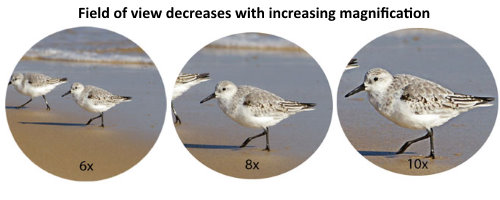
A wider FOV will enable beginners to find birds easier and track them as they move about.
However, a wider field of view on a cheap pair of binoculars is not always a better choice.
Inexpensive wide-angle models nearly always obtain a wide angle at the expense of image sharpness.
It's better to have a sharp, clear smaller field of view than a larger fuzzy one.
Again, decide what's most important to you...
Do you want a larger field of view or more magnification? Test drive as many as you can.
Nikon Action Binoculars With Excpetional Wide FOVs
Just remember, field of view decreases as magnification increases.
Verify this by checking the FOV on the manufacture's specifications for the model of binoculars you are interested in.Prism and Lens Coatings
In terms of light-gathering power, objective diameter and exit pupil size are not the only important parameters.
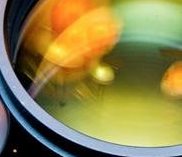
Lens coatings are just as important in increasing light transmission and improving image brightness. Each time light enters or leaves a piece of glass, about 5% is reflected back.
Binoculars may have 16 air-to-glass surfaces, with light lost at every surface.
This lost light bounces around inside the binoculars, making the image hazy and hard to see.
Lens coatings effectively lower reflection losses which finally results in a brighter and sharper image.
For example, a 8x40 binocular with good optical coatings will yield a brighter image than an uncoated 8x50 binocular, even though the larger 50mm lens allows more light in.
A classic lens coating material is magnesium fluoride which reduces reflections from 5% to 1%.
Modern lens coatings consist of complex multi-layers and reflect only 0.25% or less to yield an image with maximum brightness and natural colors.
For roof-prisms, anti-phase shifting coatings (p-coatings) are sometimes used which significantly enhance resolution and contrast.
The presence of a coating is typically denoted on a binocular by the following terms:
- Coated (C) - A single layer on at least one lens surface.
- Fully Coated (FC) - A single layer on all air-to-glass surfaces.
- Multi-Coated ( MC) - Multiple layers on at least one lens surface.
- Fully Multi-Coated (FMC) - Multiple layers on all air-to-glass surfaces.
- Phase-Correction (PC) - A coating to color phase correct the prisms
So as with everything else, more coatings, more cost, but better images through your birding binoculars.
You'll have to shop & compare to see what's the best you can get for your $ and without compromising image quality and brightness. Test drive if you can!
Types of Prism Glass
Prism glass is what often separates a $200 pair of binoculars from a $2,000 pair.
If you take a look around at forums discussing binocular pros and cons, especially high end models, birders will talk about glass distortions, chromatic aberrations, fringing, better edges, dull colors, bigger sweet spot and better depth and contrast at low light.
Some of the high-end brands include Swarovski, Zeiss, Leica, Nikon, Celestron and Steiner.
Prism Glass Designations:
- BK7- Borosilicate Crown Glass - cheapest prism glass, often in porro-prism binoculars.
- BaK4 - Barium Crown - higher density glass for better light transmission and sharper images
- ED or EX - Extra Low Dispersion - Controls chromatic aberrations
- FL - Fluoride ion containing glass for brilliant image quality and better colors
- HD - A confusing marketing term, meaning "High Definition" images. It may
mean that there are additional lens coating, but sometimes is just a
denotation that it is high-definition because it has ED glass.
You have to read the particular binocular model description because there is no standard definition for HD and may vary from binocular to binocular
.
For myself, I'm perfectly happy with the Monarch 5 8x42 binoculars.
Once when I was doing bird counts for work, my colleague loaned me a pair of $2k Swarovski's.
Yes, they were nice, but it didn't make a difference as far as my ability to identify a bird whether I had my $270 Monarchs or the $2K Swarovskis.
If you're the type to notice flaws like aberrations and not having perfectly smooth edges and be bothered by them, go for the upgrade - if you have the cash that is.
Best Binoculars with the highest quality prism glass
I would definitely suggest you borrow a pair to compare against cheaper binoculars and really see if it matters to you.
Otherwise, especially if you are a beginner birder, go with a mid-priced binocular until you get more experience and then upgrade.
On the other extreme - DO NOT get the cheapest pair of binoculars either...
There is a happy medium here and that's why we suggest the mid-price level.
The reason being, if you get a pair of $50 binoculars, you will be frustrated because the glass quality is so low it will be hard to focus and images will be dull and dark, instead of crisp and bright.
In addition, people usually make the mistake of getting too much magnification in a cheap binocular which makes it extremely hard to view moving birds because the FOV is so small.
Binocular Weight
Thanks to technology, we don't have to lug around 4 pound binoculars.
But weight is still a factor.
When you start looking around at the various binoculars available today, you will see that they can range in weight from 10 ozs (compact 8x25s) to 44ozs (large 10x50s). Although you can find compacts of the same size that weigh more as well as 10x50s that weigh less.
If you are deciding on a pair of binoculars and one weighs 26 ounces, the other 30, don't chose the lighter one based on that factor alone. Most people won't notice that kind of weight difference, even after using them all day.
As a general guideline, for long days of birding, choose a binocular that weighs less than 30 oz.
Weight distribution, or balance of the binoculars, may be more of an important factor than weight alone.
A poorly balanced 25 oz binocular may cause more fatigue than a well-balanced 32 oz pair.
The balance affects the feel in your hands, and over a long day of birding, this may be a fatiguing factor.
Your hands, wrists and/or arms may notice the difference. So again, test driving is always a good way to determine what's best for you.
If not, it's safe to assume the higher quality, more expensive binoculars will have better weight distribution & balance.
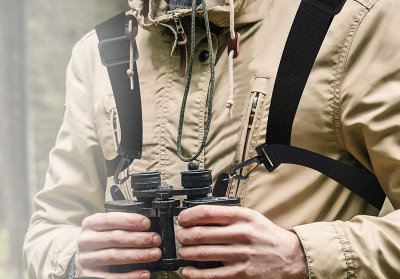
Also, to help with weight fatigue, today's harnesses are a good option over the standard neck straps to relieve neck and shoulder strain when using your birding binoculars.
Binocular Waterproofing
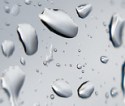 Waterproof optics provide protection against not only water, but also dust, dirt, cracker crumbs, etc. as well as internal fogging.
Waterproof optics provide protection against not only water, but also dust, dirt, cracker crumbs, etc. as well as internal fogging.
It is certainly a nice option, especially for active birders. Waterproof seals are made with rubber O-rings and and nitrogen gas purging.
If you take your warm binoculars to go birding on a chilly morning without nitrogen gas-filled optics, they will most likely fog-up on the interior because of the quick temperature change from warm to cold.
You'll be bummin' when you can't see anything through the fog!
And you never know...you just may slip when crossing that creek. It would be nice to know your binoculars are waterproof.
It is also a plus if you live in humid climates.
Rubber Armored Coating
Just so there is no misunderstanding, rubber armored coating does not provide waterproofing.
waterproofing.
Rubber armoring is a nice option (at the cost of a little extra weight & cash) that protects your birding binoculars from bumps, scratches, and corrosion.
It also provides a comfortable, cushioned gripping surface.
It certainly will be more comfortable to hold a rubber-coated pair of binoculars on very cold or hot days. Just another option for you to consider.
Birding Binoculars We Use & Recommend
One of our all-time favorite mid-priced binoculars for birding have been the Nikon Monarch 5 ATB 8x42 Binoculars (Review).
More Reviews of Favorites
Bushnell Legend Ultra HD 10x42 Binoculars - Another good choice in the mid-price range, especially if you want the 10x magnification.
Nikon Monarch Binoculars - Comparison of All Monarch Models
Budget Nikon Action Binoculars - Comparison of Models
Swarovski SLC HD Binoculars Review - One of the Best of the Best
Best Birding Binoculars - Our picks in 3 price ranges.
Best 8x42, 7x50, and 10x50 Binoculars
Types of Binoculars: Image Stabilized, Jason, Mini, Zoom, High Power, Digital, Infrared, Kids
Best Image Stabilized Binoculars for Birding - Clearer images with no blur/shake from hands.
Jason Binoculars - Auto Focusing Binoculars - Automatically focuses on objects
Best Mini Binoculars - Lightweight compact binoculars
Best Rangefinder Binoculars - For estimating distances to objects
Binoculars for Kids - Best binoculars for children
Best Zoom Binoculars - Instead of one fixed magnification, these binoculars can zoom, for example, from 10x-20x
High Power Binoculars - High power magnification (15x+) for viewing at long distances and stargazing
Digital Binoculars with Camera and Video Built-In - Take photos and videos with your binoculars
Infrared Binoculars - Night vision binoculars
Best Marine Binoculars - For viewing on moving boats with compass and reticle
No More Binocular-Neck... Get a Harness!
Binocular Harness - Reduces strain on your neck by distributing the weight
Binocular Tripod Adapter
Binocular Tripod Mount - For a more steady view with less strain on arms
Care & Repair
Binocular Care - How to clean and care for your binoculars
Nikon Binoculars Repair - How to contact Nikon for repair
Spotting Scopes
Best Bird Watching Spotting Scopes - Reviews of the best spotting scopes
Audubon Bird Watchng Binoculars Guide
Best Cheap Binoculars - Budget binoculars that aren't too cheap that they're useless
Birdwatching Binoculars FAQs
What are the best bird watching binoculars for beginners?
The best beginner birding binoculars would be one with a wide field of view that makes it easy to initially find birds, especially smaller birds that move quickly. We recommend these magnification/objective lens sizes for beginning birders: 7x35, 8x42, 10x42 or 10x50
Should I choose 8x or 10x bird watching binoculars?
For your first pair we recommend 8x42 binoculars that will be suitable for most birding habitats. If you know you will be using the binoculars at longer ranges in wide open spaces like in coastal areas, marshes, open fields, etc.. then 10x42 or 10x50 would be a good choice.
What are the best binoculars for the money?
You don't have to spend over $1,000 for your binoculars if you don't want to. You can find quality binoculars in the mid-priced range from $200 - $500 that will enable you to view clear images of birds for identification.
View best mid-priced binoculars on our best bird watching binoculars page
Best Size Binoculars for Bird Watching
There isn't a definitive best size for birding binoculars. For a beginner, an 8x42 binocular has enough magnification for identifying birds and wide enough field of view to help with locating birds, especially those moving quickly in thick brush or trees. 7x35, 10x42 and 10x50 are all good binoculars for birdwatching as well.
Best Budget Binoculars for Bird Watching
I touched upon getting budget binoculars throughout this page, but in general it's best not to get a pair of binoculars under $100 because quality really begins to suffer in this low price range with cheaper lenses and prisms.
With the money you save, you will suffer with poor quality images that will be difficult to view with any brightness and focus, as well as even tracking birds down through the binouclars to find them in the first place.
But read our best budget binoculars page to get some recommendations if you are looking for binoculars that won't be too expensive without sacrificing too much quality.
How to Choose Birding Binoculars Summary
|
Our Favorite Bird Watching Binoculars, Squirrel-Proof Feeder & Hummingbird Feeder Read Our Reviews: |
||
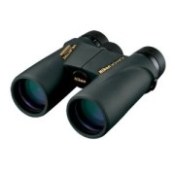
Nikon Monarch M5
Best mid-priced bird watching binoculars. Waterproof, shockproof, multi-coated ED-Glass. |
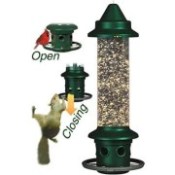
|
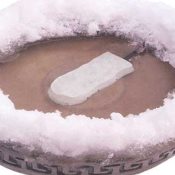
Bird Bath Heater
Keeps your bird baths ice-free down to -20 F. Low-operating costs ~$1/mo |
| Click Images or Links To View More Info | ||
